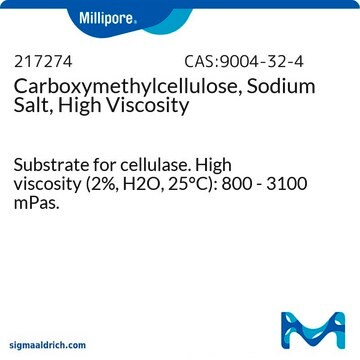Products may be shipped at a different temperature than the recommended long-term storage temperature. If the product quality is sensitive to short-term exposure to conditions other than the recommended long-term storage, it will be shipped on wet or dry-ice. If the product quality is NOT affected by short-term exposure to conditions other than the recommended long-term storage, it will be shipped at ambient temperature. As shipping routes are configured for minimum transit times, shipping at ambient temperature helps control shipping costs for our customers. For more information, please refer to the Storage and Transport Conditions document: https://www.sigmaaldrich.com/deepweb/assets/sigmaaldrich/marketing/global/documents/316/622/storage-transport-conditions-mk.pdf
419338
Sodium carboxymethyl cellulose
viscosity 2500-6000 cP
Sinonimo/i:
Carboxymethylcellulose sodium salt
Scegli un formato
Scegli un formato
About This Item
Prodotti consigliati
Stato
powder
Livello qualitativo
Temp. autoaccensione
698 °F
Grado di funzionalizzazione
0.9 carboxymethyl groups per anhydroglucose unit
Viscosità
2500-6000 cP
Punto di fusione
270 °C (dec.)
Stringa SMILE
[Na].OC(C(O)C(O)C=O)C(O)CO.OC(=O)C
InChI
1S/C6H12O6.C2H4O2.Na/c7-1-3(9)5(11)6(12)4(10)2-8;1-2(3)4;/h1,3-6,8-12H,2H2;1H3,(H,3,4);
DPXJVFZANSGRMM-UHFFFAOYSA-N
Cerchi prodotti simili? Visita Guida al confronto tra prodotti
Categorie correlate
1 of 4
Questo articolo | 419273 | 419281 | 419311 |
|---|---|---|---|
| form powder | form powder | form powder | form powder |
| mp 270 °C (dec.) | mp 274 °C (dec.) | mp 270 °C (dec.) | mp 260 °C (dec.) |
| autoignition temp. 698 °F | autoignition temp. 698 °F | autoignition temp. 698 °F | autoignition temp. 698 °F |
| mol wt average Mw ~700,000 | mol wt - | mol wt average Mw ~250,000 | mol wt average Mw ~250,000 |
| extent of labeling 0.9 carboxymethyl groups per anhydroglucose unit | extent of labeling 0.7 carboxymethyl groups per anhydroglucose unit | extent of labeling 1.2 carboxymethyl groups per anhydroglucose unit | extent of labeling 0.7 carboxymethyl groups per anhydroglucose unit |
Descrizione generale
Applicazioni
Codice della classe di stoccaggio
11 - Combustible Solids
Classe di pericolosità dell'acqua (WGK)
WGK 1
Punto d’infiammabilità (°F)
Not applicable
Punto d’infiammabilità (°C)
Not applicable
Dispositivi di protezione individuale
Eyeshields, Gloves, type N95 (US)
Scegli una delle versioni più recenti:
Possiedi già questo prodotto?
I documenti relativi ai prodotti acquistati recentemente sono disponibili nell’Archivio dei documenti.
I clienti hanno visto anche
-
How is shipping temperature determined? And how is it related to the product storage temperature?
1 risposta-
Utile?
-
-
How can I determine the shelf life / expiration / retest date of this product?
1 risposta-
If this product has an expiration or retest date, it will be shown on the Certificate of Analysis (COA, CofA). If there is no retest or expiration date listed on the product's COA, we do not have suitable stability data to determine a shelf life. For these products, the only date on the COA will be the release date; a retest, expiration, or use-by-date will not be displayed.
For all products, we recommend handling per defined conditions as printed in our product literature and website product descriptions. We recommend that products should be routinely inspected by customers to ensure they perform as expected.
For products without retest or expiration dates, our standard warranty of 1 year from the date of shipment is applicable.
For more information, please refer to the Product Dating Information document: https://www.sigmaaldrich.com/deepweb/assets/sigmaaldrich/marketing/global/documents/449/386/product-dating-information-mk.pdfUtile?
-
-
Is this compound suitable for In vivo work?
1 risposta-
This product has not been tested for in vivo or in vitro use. However, based on a review of the peer-reviewed papers, this material has been used in animal models. Please see the link below to review this publication: https://onlinelibrary.wiley.com/doi/10.1002/adhm.201400250
Utile?
-
-
I am trying to buy CMC that is the same as the one used in batteries, but I am not sure how the Molecular weight would affect its properties. would it matter if it was high or low?
1 risposta-
Carboxymethyl Cellulose Sodium serves as a binder for electrode materials in batteries. The molecular weight is irrelevant as long as all the components (active material, binder, conductive agent) can be immobilized on the current collector without obvious agglomeration or exfoliation. One reference suggested that lower molecular weight CMC produced 'lower charge transfer resistance, higher ion conductivity, better wettability with the electrolyte, and better Li+ mobility as LIB binder.' Should a lower molecular weight material be of interest, see CMC product 419274, average Mw ~90,000. See the links below to review this product page as well as the reference cited above.
419273, Sodium Carboxymethyl cellulose
https://www.sigmaaldrich.com/product/aldrich/419273Assembly and electrochemical testing of renewable carbon-based anodes in SIBs: A practical guide
https://www.sciencedirect.com/science/article/pii/S209549562200479XSodium carboxymethyl cellulose as a potential binder for hard-carbon negative electrodes in sodium-ion batteries
https://www.sciencedirect.com/science/article/pii/S1388248114001209Utile?
-
Filtri attivi
Il team dei nostri ricercatori vanta grande esperienza in tutte le aree della ricerca quali Life Science, scienza dei materiali, sintesi chimica, cromatografia, discipline analitiche, ecc..
Contatta l'Assistenza Tecnica.
![Poly[(o-cresyl glycidyl ether)-co-formaldehyde] average Mn ~870](/deepweb/assets/sigmaaldrich/product/structures/492/686/3e332037-f67b-49a2-8326-268fc7b0b900/640/3e332037-f67b-49a2-8326-268fc7b0b900.png)


